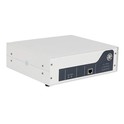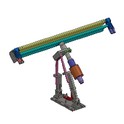Can ultrasonic vibration tables be used for nano - material processing?
In recent years, nanomaterials have emerged as a revolutionary field in materials science, with applications spanning from electronics and medicine to energy and environmental science. Their unique properties, such as high surface - to - volume ratio, quantum size effects, and enhanced reactivity, make them highly sought - after for advanced technological applications. As a supplier of ultrasonic vibration tables, I often get asked whether our products can be used for nano - material processing. In this blog post, I will explore the potential of ultrasonic vibration tables in the processing of nanomaterials.
Understanding Ultrasonic Vibration Tables
Before delving into their application in nano - material processing, let's first understand what ultrasonic vibration tables are. Ultrasonic vibration tables are devices that generate high - frequency mechanical vibrations, typically in the ultrasonic range (above 20 kHz). These vibrations are produced by ultrasonic transducers that convert electrical energy into mechanical vibrations. The vibrations are then transmitted to the table surface, where they can be used to manipulate materials placed on the table.
Our company offers a range of ultrasonic vibration tables, including the ResoTab - F20A Ultrasonic Vibration Tables, ResoTab - F20 Ultrasonic Vibration Tables, and ResoTab - P20 Ultrasonic Vibration Tables. These tables are designed with precision and are capable of generating stable and uniform ultrasonic vibrations, which are essential for effective material processing.
Applications of Ultrasonic Vibration in Nano - Material Processing
Dispersion of Nanoparticles
One of the primary challenges in working with nanomaterials is the agglomeration of nanoparticles. Nanoparticles have a strong tendency to stick together due to van der Waals forces and electrostatic interactions. Agglomerated nanoparticles can significantly reduce the performance of nanomaterials in various applications. Ultrasonic vibration can be used to break up these agglomerates and disperse the nanoparticles evenly in a liquid medium.
When ultrasonic waves propagate through a liquid containing nanoparticles, they create alternating high - and low - pressure regions. In the low - pressure regions, small bubbles are formed, which grow and then collapse violently in the high - pressure regions. This phenomenon, known as cavitation, generates intense local shear forces and shock waves. These forces can break the agglomerates apart and disperse the nanoparticles, ensuring a more homogeneous distribution.
For example, in the preparation of nanocomposites, where nanoparticles are incorporated into a polymer matrix, ultrasonic vibration can be used to disperse the nanoparticles uniformly in the polymer solution before curing. This results in nanocomposites with improved mechanical, electrical, and thermal properties.
Nanoparticle Synthesis
Ultrasonic vibration can also play a crucial role in the synthesis of nanoparticles. The high - energy environment created by cavitation can accelerate chemical reactions and promote the formation of nanoparticles. For instance, in the sonochemical synthesis of metal nanoparticles, ultrasonic waves can reduce metal salts to their corresponding metals. The cavitation bubbles act as micro - reactors, providing a high - temperature and high - pressure environment for the chemical reactions to occur.
The size and shape of the nanoparticles can be controlled by adjusting the ultrasonic parameters such as frequency, power, and duration. Different frequencies can affect the cavitation behavior and, consequently, the growth and nucleation of nanoparticles. By optimizing these parameters, it is possible to synthesize nanoparticles with specific sizes and morphologies, which are often critical for their applications.
Surface Modification of Nanomaterials
Surface modification of nanomaterials is important for enhancing their compatibility with other materials and improving their performance in various applications. Ultrasonic vibration can be used to functionalize the surface of nanomaterials. For example, ultrasonic treatment can be used to graft organic molecules onto the surface of nanoparticles. The high - energy vibrations can break chemical bonds and facilitate the reaction between the nanoparticles and the functionalizing agents.
In addition, ultrasonic vibration can clean the surface of nanomaterials by removing impurities and contaminants. This is particularly important for nanomaterials used in biological and medical applications, where surface cleanliness can affect their biocompatibility and performance.


Advantages of Using Ultrasonic Vibration Tables for Nano - Material Processing
Non - Contact and Non - Invasive
Ultrasonic vibration is a non - contact method of material processing. This means that the ultrasonic waves can act on the nanomaterials without physically touching them. This is beneficial for delicate nanomaterials that may be easily damaged by mechanical contact. Moreover, it reduces the risk of contamination from processing tools, which is crucial for applications where high purity is required.
Energy - Efficient
Compared to some traditional methods of nano - material processing, ultrasonic vibration is relatively energy - efficient. The energy is concentrated in the ultrasonic waves, which can be precisely controlled to target the specific processing needs. This results in lower energy consumption and reduced processing costs.
Scalability
Ultrasonic vibration tables can be easily scaled up for industrial - scale production of nanomaterials. Our ultrasonic vibration tables are designed to handle different volumes of materials, making them suitable for both laboratory - scale research and large - scale manufacturing.
Challenges and Limitations
Despite the many advantages, there are also some challenges and limitations associated with using ultrasonic vibration tables for nano - material processing. One of the main challenges is the control of ultrasonic parameters. The effectiveness of ultrasonic processing depends on factors such as frequency, power, and duration. These parameters need to be carefully optimized for different nanomaterials and processing requirements. Incorrect parameter settings can lead to over - processing or under - processing, which can affect the quality of the nanomaterials.
Another limitation is the potential for the degradation of nanomaterials. The high - energy environment created by cavitation can sometimes cause the degradation of nanomaterials, especially those that are sensitive to mechanical and thermal stress. Therefore, it is necessary to carefully select the ultrasonic parameters and processing conditions to minimize the risk of degradation.
Conclusion
In conclusion, ultrasonic vibration tables have great potential for nano - material processing. They can be used for dispersion, synthesis, and surface modification of nanomaterials, offering several advantages such as non - contact processing, energy efficiency, and scalability. However, careful consideration of ultrasonic parameters and processing conditions is required to overcome the challenges and limitations.
As a supplier of ultrasonic vibration tables, we are committed to providing high - quality products and technical support to our customers. If you are interested in using ultrasonic vibration tables for nano - material processing, we would be more than happy to discuss your specific requirements and provide you with the most suitable solutions. Please feel free to contact us for further information and to start a procurement discussion.
References
- Suslick, K. S., & Price, G. J. (1999). Applications of ultrasound to materials chemistry. Annual Review of Materials Science, 29(1), 295 - 326.
- Zhong, Z., & Zheng, J. (2012). Sonochemical synthesis and applications of inorganic nanomaterials. Chemical Society Reviews, 41(20), 6889 - 6906.
- Zhang, X., & Wang, Y. (2015). Ultrasonic - assisted dispersion and functionalization of carbon nanotubes in polymers. Journal of Applied Polymer Science, 132(32), 42023.






